Unsung Producer: Erik Jacobsen
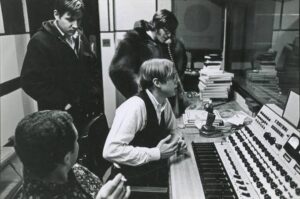
American producer Erik Jacobsen crafted some of the most beautiful and strange music of the mid 60´s San Francisco. A forming member of Lovin´ Spoonful, Jacobsen moved from New York to San Francisco and further developed his cutting- edge production techniques. Summer in the City and Daydream being fine examples of his skills that defined an era and predicted a possible future.Erik Jacobsen was born in Oak Park, near Chicago. A descendant of Norwegian settlers who migrated from Larvik, a small town on the east coast of Norway – home of electronic music pioneer and composer Arne Nordheim and a string of fine jazz musicians including pianist Bugge Wesseltoft and drummer Audun Kleive.
Originally a bluegrass musician, he didn´t see a future with the form. After hearing the Beatles in a jukebox joint, he changed direction and moved to Greenwich Village in New York with the goal of becoming a record producer. The melodic bass playing introduced by Paul McCartney and Motown bass player, James Jamerson inspired him in search of new ways of expression. His producing style included tape looping and cut n´paste techniques.
Taking their name from a British fighter aircraft, Sopwith Camel released two albums between 1967 and 1973. The incredible “Fazon” from the Sopwith Camel´s last album “The Miraculous Hump Returns from the Moon» is a fine example of his abilities to sculpt in sound. The saxophone double tracking is just a wonderful idea that would anticipate a future vision of the Eventide harmonizer still a decade apart.
By 1967, Erik Jacobsen had moved to San Francisco and produced Tim Hardin and fellow Spoonful member John Sebastian. Another great example of his production skills is the Norman Greenbaum 1969 album “Spirit in the Sky” that could possibly have been the-one-album that triggered the Motown a/r staff enough to pay him a visit inviting Jacobsen to start working for the label. This was around the same time that Norman Withfield developed his psychedelic soul sound.
Jacobsen also produced The Charlatans that included Dan Hicks, composer of the gorgeous “I Scare Myself” later appearing on Thomas Dolby´s 1984 album The Flat Earth. Regular Flowworker readers may also recognize Compass Point guitarist, Barry Reynolds hidden classic album I Scare Myself. These types of songs that appear and reappear every now and then in different versions, finding new audiences.
Jan Bang
2024: Eleven albums you should listen to
- Beth Gibbons – Lives Outgrown
- Willie Nelson – Last Leaf On The Tree
- Fabiano do Nascimento & Sam Gendel – The Room
- The Cure – Songs Of A Lost World
- Santi Careta – A Milers De Somnis De Distànsa
- Gunnar Sønstevold/Mai Sønstevold – The Kitchen Counter Experiments And Other Electronic Works (1959-1984)
- Andrea Giordano – Pearlescent Dark
- Erik Honoré – Triage
- Tyla – Tyla
- Charlie XCX – Brat
- Ganavya – Daughter Of A Temple
A personal favorite of mine from 2024 is the duo album entitled The Room, from LA based, Brazilian guitarist Fabiano Nascimento and saxophone player Sam Gendel. The latter has also released an album together with Norwegian fidler Hans Kjorstad. Its sparse arrangements and strong musicianship leans on Brazilian music of bossa, jazz and folk.
Erik Honoré made his best album under his own name in 2024. Triage carries themes that can be found on his previous solo releases Heliographs (2014) and Unrest (2017). Beautifully produced, it ties old recordings with the new ones. A perfectly balanced album, at least in my book.
Perhaps the most surprising release of the year came from Willie Nelson. The Last Leaf On The Tree is a set of (mostly) cover songs by the senior C&W singer. A swan song that is full of beauty, protest songs and advice for young people. Produced and curated by Micah Nelson it features among others Daniel Lanois on pedal steel.
Two dance albums that intrigued me: South African singer Tyla´s self titled debut album, and the Charlie XCX´ Brat long player. Both sounds fresh and daring while still being accessible.
Italian singer Andrea Silvia Giordano, currently based in Oslo released a large ensemble album dedicated to her late Italian mentor. The album carries a set of nine Stansia songs expressing fatigue or perhaps a life ending. Giordano studied with Sidsel Endresen at the Norwegian Academy in Oslo. She has collaborated with among others video artist Kjell Bjørgeengen and Eivind Lønning. The latter also a sometime collaborator with Erik Honoré.
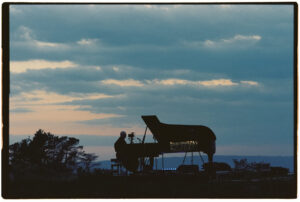
Together with Eivind Aarset I was invited to play at Laboratory of Arts in a small village of Tavertet outside Barcelona. A community of Tibetan Buddhist practitioners. We stayed for a week and listened to performances in between mediation lessons, masterclasses and mountain walks. Indian/US singer Ganavya came with her mom and dad, both appearing on her 2024 album. Celebrating midsummer night, Nik Bartsch, Shai Maestro and EST dummer, Magnus Öström joined us for our performance. A beautiful night. Listening to Ganavya´s masterclass, a lecture on classical Indian raga was both intentional demystifying and inspiring. I was also impressed by Catalonian guitarist Santi Careta and his performance with pianist Clara Peya. Santi Careta´s solo album A Milers de Somnis de Distànsa is a set of songs sung by Careta himself. Worth checking out.
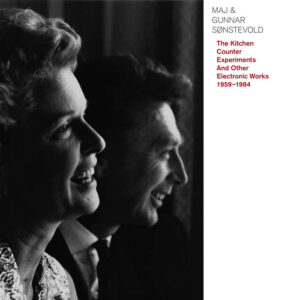
Norwegian electronic pioneers Gunnar and Mai Sønstevold homemade «kitchen» recordings has been carefully collected and restored by the eminent Lasse Marhaug as The Kitchen Counter Experiments And Other Electronic Works (1959-1984). These recordings has been made public on O.Gudmundsen Minde. Available on Bandcamp.

A little nod to Flowworker´s Michael Engelbrecht is the new Cure album. I could pull out a few tracks from their extensive catalogue. I must admit I fell off their releases after a while, but Alone from Songs From A Lost World would be a good start to their extensive catalogue.
From her tenure with Portishead, a band that somehow left me cold, Beth Gibbons´Lives Outgrown is a work of a matured songwriter and performer. What once felt insecure and perhaps therefore had traces of Billy Holiday has gradually turned into something deeply personal.
– Jan Bang
Pre-existing Commitments: Mark Wastell
Open letter to Mark Wastell:
„Just listened through your new cello recording and find it absolutely powerful, and quite unusual. I can only think of the piece «Battle of Armageddon» by Alice Coltrane as something that has this insisting powerful playing with the sparse use of only a few elements. In her case the organ and Rashid Ali’s drums. Similar with your cello overdubs which never seem overloaded in the 40 minutes of its duration. Well done.“ – J. Bang
Desert Island Collection
10 Songs Close for Comfort
- Glenn Gould: Brahms Intermezzi no.4.
- Caetano Veloso / Gal Costa: Domingo
- Holger Czukay: Boat Woman Song
- Brian Eno: On Land
- Guy Lombardo: Enjoy Yourself (Its Later Than You Think)
- Talking Heads: Nothing but Flowers
- Jack Jones: The Christmas Album
- Toru Takemitsu: In An Autumn Garden
- Martin Denny: Forbidden Island
- Music of Arabia: Dramatic Representation of Tribal Quarrel (unspecified)
Stranded on a desert island, I would love to have with me a set of songs that would either remind me of my previous home or something that could make me laugh of the absurdity of the situation. The Guy Lombardo track would sit well with hunger or the point of insanity. The same goes for David Byrne´s glorious lyrics to Nothing but Flowers. «Dont leave me stranded here / I can’t get used to this llifestile». The Jack Jones Christmas album would remind me of both my childhood and our house, but maybe more of my own family as our favorite album of the season. I once performed the Takemitsu piece with a famous Gagaku Orchestra in Tokyo´s Metropolitan Theatre. I would bring that to remind me of my friend Dai Fujikura. Oh, and the unspecified track of a tribal quarrel – likely to have been staged for recording purposes – but would be useful to scare away unwanted company or predators. I would bring the Glenn Gould and the Veloso/Costa recordings, just because of its sheer beauty. (Jan Bang)
Man with Tie – Jean Phillippe Laurent

(Photos by Alf Solbakken, Svein Kruse and Per Fronth)
Reading Ingo Biermann´s post on one hundred albums from the 80´s, my immediate respond was to start listing albums of that decade. Albums that are not necessarily fully formed as such, more that each album had a few songs here and there that in one way or another had captured my attention, and I guess also may have influenced my own work.
Putting down names and titles on that list made me think of an old friend and painter I met at the time and became my friend in 83. His name was Phillippe Laurent, a striking figure that brought a fair amount of cosmopolitan attitude and the zeitgeist of the time to the sleepy town of Kristiansand. Phillippe painted powerful images on large canvases using any given or stolen paint he would find. Often the paint used was double-coated industrial paint that would harm the skin when touching.
Phillippe created gorgeous and shocking happenings i.e. placing military tanks made from painted lawnmowers outside the Parliament in Oslo. On each side, a pile of burning rubber wheels and himself armed with a motor chain, screaming. Within minutes it was all over. He would run off into the streets before the police and fire department would enter the scene.

Installation outside the Parliament in Oslo 81-82.
His paintings – primitive, but strikingly beautiful made a huge impression on me. I used to hang around Phillippe and visited his atelier and still recall the smell of industrial paint and the large-scale paintings placed on the asphalt in the backyard. His father, an ex-military working at Charles de Gaulle commuting between Paris and Geneva. During Phillippe´s frequent trips to metropolitan cities, he would pick up vinyl records and record them onto tapes that suited as a soundtrack to his prolific paintings of that period.
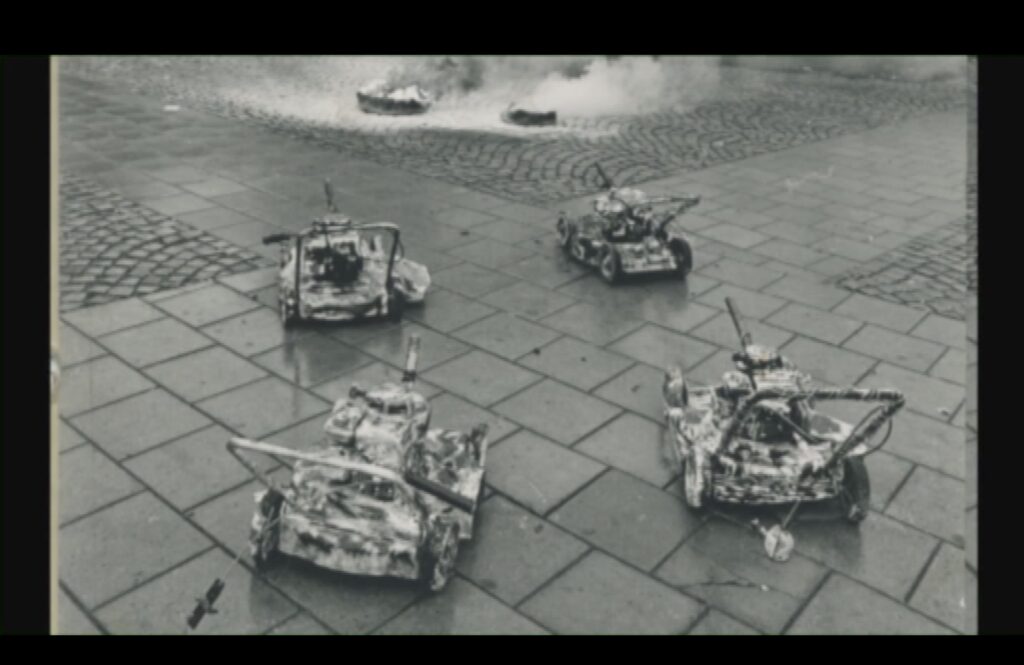
A mixtape of Phillippe would be something like the following:
- 23 Skidoo – Kundalini (82)
- C-Cat Trance – Dalbouka (87)
- Chrome – Tribes (83)
- Chris & Cosey – Shivers (85)
- Kowalski – Der Arbeiter (83)
- DAF – Goldenes Spielzaug (81)
- Spliff – Das Blech (82)
- John Foxx – On the Plaza (80)
- Blancmange – Feel Me (82)
- Blancmange – Game Above My Head (83)
- Schriekback – My Spine is the Bassline (82)
- Yello – I Love You (83)
- Cabaret Voltaire – Dream Ticket (83)
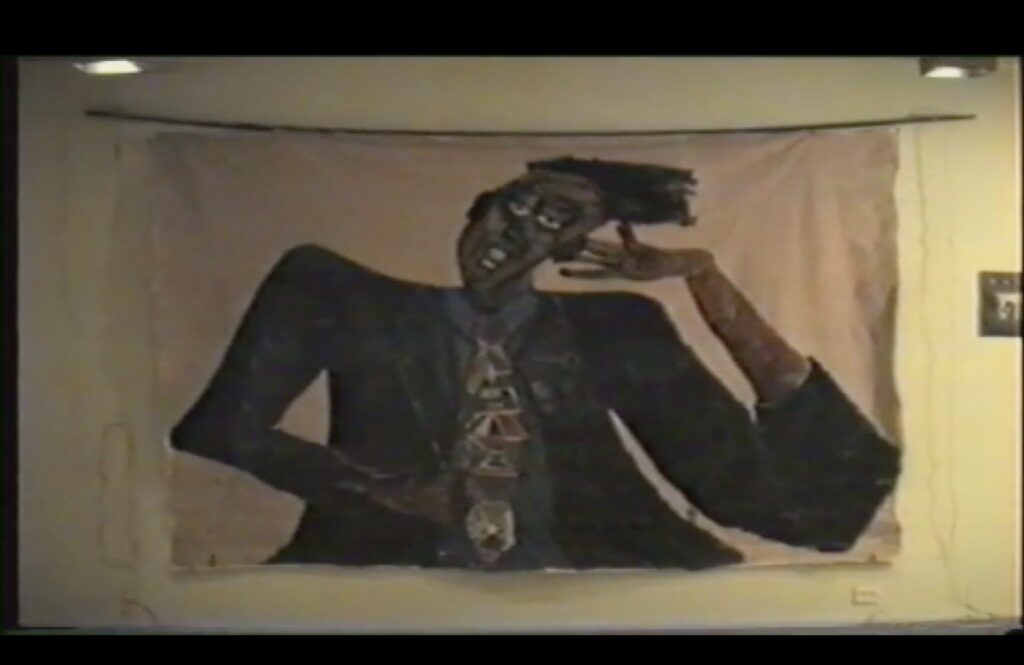
Man With Tie (Phillippe Laurent). Image taken from the video “Jean Phillippe Laurent”
By the end of the decade his psychoses became more prominent. He was constantly laughing as if his own laughter would put an end to his nightmares. A strong character and a powerful imaginative painter with an impeccable sense of colors. A film about Phillippe Laurent was made in 2009 by Jonas Matzow Gulbrandsen and with Punkt photographer and painter, Alf Solbakken as narrator.
101 albums: 1980 – 89
- Viriginia Astley – From Gardens Where We Feel Secure (1983)
- 23 Skidoo – Seven Songs (1982)
- David Bowie – Baal (1982)
- Michael Brook – Hybrid (1985)
- Paul Simon – One Trick Pony (1980)
- Working Week – Working Nights (1985)
- Chris & Cosey – Techno Primitive (1985)
- Arvo Pärt – Tabula Rasa (1984)
- Smiths – The Queen is Dead (1986)
- Laurie Anderson – Big Science (1982)
- Phil Manzanera – Primitive Guitars (1982)
- Simple Minds – New Gold Dream (1982)
- Fun Boy Three – Self Titled (1982)
- Frank Sinatra – She Shot Me Down (1981)
- Brian Eno – On Land (1982)
- Flying Lizards – Fourth Wall (1981)
- Talking Heads – Remain in Light (1980)
- Jon Hassell – Dream Theory in Malaya. Fourth World vol.2 (1981)
- Judy Mowatt – Black Woman (1980)
- Roxy Music – Avalon (1982)
- Grace Jones – Living My Life (1982)
- XTC – Skylarking (1986)
- Thomas Dolby – The Flat Earth (1984)
- David Sylvian – Brilliant Trees (1984)
- Roger Eno – Voices (1985)
- Style Council – Our Favorite Shop (1985)
- Prefab Sprout – Steve McQueen (1985)
- Peter Gabriel – Birdy (1985)
- Mathilde Santing – Too Much (1985)
- John Cale – Artificial Intelligence (1985)
- Jan Garbarek – All Those Born with Wings (1987)
- Harold Budd – The Pearl (1984)
- Manu Dibango – Melodies Africaines vol.2 (1984)
- Jon Hassell – Aka Darbari Java (1983)
- Talking Heads – Speaking in Tongues (1983)
- Philip Glass – Glassworks (1982)
- Brian Eno – Apollo (1983)
- Gwen Guthrie – Portrait (1983)
- King Sunny Ade – King of Juju (1983)
- Chrome – Raining Milk (1983)
- Instrumental Music From the Kalahari San (1982)
- African Head Charge – Environmental Studies (1982)
- Thompson Twins – Quick Step Side Kick (1982)
- Talk Talk – Spirit of Eden (1988)
- Gwen McCrae – Self titled (1981)
- Rip Rig and Panic – I Am Cold (1982)
- Daniel Lanois – Acadie (1989)
- Donna Summer – Living in America (1982)
- Michael Jackson – Thriller (1982)
- Kid Creole and the Coconuts – Tropical Gangsters (1982)
- Joao Gilberto, Caetano Veloso & Giilberto Gil – Brazil (1981)
- Brian Eno / David Byrne – My Life in the Bush of Ghosts (1981)
- David Sylvian – Secrets of the Beehive (1987)
- Police – Ghosts in the Machine (1981)
- Scientist – The Scientist Rids the World of the Evil (1981)
- David Byrne – The Catherine Wheel (1981)
- David Bowie – Scary Monsters and Super Creeps (1980)
- Grace Jones – Nightclubbing (1981)
- Richard Horowitz – Eros in Arabia (1981)
- Cure – Head on the Door (1985)
- The Jones Girls – Get As Much As You Can (1981)
- Sun Ra – Love in Outer Space (1980)
- Earth Wind and Fire – Faces (1980)
- Roxy Music – Flesh and Blood (1980)
- Jon Hassell / Brian Eno – Possible Musics. Fourth World vol.1 (1980)
- Black Uhuru – Sinsemilla (1980)
- Maze – Joy and Pain (1980)
- Ryuichi Sakamoto – Riot in Lagos (1980)
- Laura Spiegel – The Expanding Universe(1980)
- Unlimited Touch – Searching to find the one (1980)
- Specials – More Specials (1980)
- Norman Harris – The Harris Machine (1980)
- Michael Franks – One Bad Habit (1980)
- Indoor Life – Contre Nature (1980)
- Scott Walker – Climate of Hunter (1984)
- Simple Minds – Empires and Dance (1980)
- George Benson – Give Me the Night (1980)
- Linton Kwesi Johnson – Bass Culture (1980)
- Daryl Hall & John Oates – Private Eyes (1981)
- The Durutti Column – LC (1981)
- Nico – Camera Obscura (1985)
- Susanne Vega – Self titled (1985)
- Neville Brothers – Yellow Moon (1989)
- Marc Almond – Mother Fist (1987)
- Jennifer Warnes – Famous Blue Raincoat (1987)
- Susann Deyhim & Richard Horowitz – Desert Equations (1986)
- Peter Gabriel – So (1986)
- Arthur Russell – World of Echo (1986)
- Laurie Anderson – Home of the Brave (1986)
- David Byrne – The Knee Play (1986)
- Le Nimba de N´ Zerekore – Gön Bia Bia (1980)
- Terry Riley – Shri Camel (1980)
- Holger Czukay – Der Osten is Rot (1984)
- John Foxx – Metal Beat (1980)
- Grace Jones – Nightclubbing (1980)
- Pablo Moses – A Song (1980)
- Heaven 17 – Penthouse and Pavement (1980)
- Robert Wyatt – Nothing Can Stop Us (1980)
- Pasteur Lappe – Pop Makossa (1980)
- Philip Glass – Songs from Liquid Days (1986)
- Prince and the Revolution – Parade (1986)
Bengt Hambraeus
CONSTELLATIONS II FOR ORGAN SOUNDS (1959)
INTERFERENCES FOR THE ORGAN
(Limelight LS-86052, 1968)

Inheritance
Bengt Hambraeus (1928-2000) was a Swedish organist, broadcaster and a mostly auto didact composer. Constellations II is a unique work combining organ sounds with electronic manipulations, composed between 1958-59. Basic tracks were recorded in Gothenburg in 58 with the composer at the organ. Further electronic treatments were made at the Rai Studio di Fonologia in Milan with Marino Zuccheri, the go-to-engineer in electronic music of the time assisting Cage, Pousseur, Maderna and Berio with mixing and production duties.
From 1957 Hambraeus worked at Swedish Radio and after receiving a PhD in organ studies at Uppsala University, he migrated to Montreal where he in 1972 became full professor of music and theory at the McGill University in Quebec. He was a pioneer of Swedish electroacoustic music. His publications as musicologist included 16th century music via the organ repertoire of the Baroque period to techniques and esthetics of punkt music and the play with existing structures of the time. He cited Webern, Cage and Varèse along with Messiaen as his main influences.
Sporadic studies at the WDR studio in Cologne and trips to France, Hambraeus attended the summer courses in Darmstadt throughout the fifties where he met with same age composers and thinkers such as Stockhausen, Boulez, Nono, Maderna and Pousseur. Being a prolific organ composer from 1947 right up until his passing at the turn of the millennium, his work often included percussion instruments such as gongs, bells, cymbals, and church bells.

Metal Beat: Hambraeus with bells
A Cosmic Tonal Experience
The sound of Constellations II is organic and playful. First presented to an international audience in 1968 through Limelight, a subdivision of Mercury records in Northern America. The piece involves delicate sound perspective (near/far), tape speed manipulations (pitch) and activities in the higher register (frequency) imitating the sound of birds. This was electronic music that was not alienated from nature. Today, when listening back to this music it sounds surprisingly fresh. Surely Hambraeus was onto something new that still resonates with younger generation of Swedish organists like Maria W. Horn. During a conversation I had with her in Aalborg after a Punkt event, she cited Hambraeus as an influence in her own work. Ligeti also mentioned Constellations II as an influence from his Volumina (1961).
Hambraeus dream was to “…create a fantastic space organ with no limitations, a cosmic tonal experience…” (Hambraeus 1962). Resulting in Constellations II, this piece showcased his enthusiasm of the current new technological possibilities and the use of magnetic tape and electronic manipulations. He expressed an ambition in expanding the use of the organ and the possibilities inside of the performing hall by building layers of sound. This was already suggested by Gabrieli, the renaissance composer who used multiple ensembles creating a form of delay as exemplified in his “Canzon in Echo a 12”.
In 1955 Hambraeus composed his first electronic music piece Doppelrohr II named after German organ-theorist E.K. Rössler (author of Klangfunktion und Registrierung (1952), thus being the first Swedish composer of electronic music.

Organ theorist E.K. Rössler
A review in High Fidelity Magazine reads:
“Constellations II is an electronic work, at times making use of the organ tone unchanged, at other times transforming it completely into a new range of timbres. The transition from one to the other is fabulous: and the general size, grandeur, and passion of the piece are most impressive.”…“Nobody has done anything quite so important with the organ since the eighteenth century. Bengt Hambraeus is the Johan Sebastian Bach of a new day”.
This album was part of my father´s record collection and has been with me all my life. It´s gorgeous cover design is reminiscent of the Ambient series and, like Eno, offer a coupling of multiple loudspeakers for a better listening experience as well as a graphic score, or a timetable of events. Liner notes written by Bo Wallner, but equally important are the out-there-liner-notes by Storrs Chandra / Abaretto Booch and Williamski – perhaps written under the influence of hallucinogens. Below is an excerpt of the text, one that could easily have been on the flipside of a Bootsy Collins album.
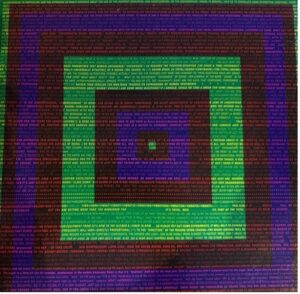
„THIS ALBUM IS….BEATLE…..FULL, AN ABSOLUTELY MAGNIFICENT RECORDING. …..BUT YOU ARE GETTING MORE THAN YOU BARGAINED FOR…..IT´S TOTAL, MAN..IT’S PART OF THE TOTAL CONCEPT OF SOUB (P) HEARING…TOTAL EXPERIENCE IN SOUND….TTL…XPRYENCE..INUH..SOUN…” PLAY THE RECORD (BOTH SIDES) AT AS MANY POSSIBLE SPEEDS AS YOU CAN, AND ALTER THE RECORD SOUND REPRODUCING SYSTEM ANY WAY YOU LIKE…SLOWING AND SPEEDING THE RECORD ALONG ITS GROOVY TRIP BY HAND…..HEARSOUNDHEARSOUNDHEARSOUND.“
The promotional department at Limelight targeted the release to a young and hip audience. The backside sticker simply says:
“Listening to Bengt Hambraeus´fantastic sound – it´s magnificent electronic and organ-organized electronic total sound experience should involve you as much as any music that you are capable of loving…be in the sound of the Beatles, Bach, Beethoven, Boulez, Beach Boys or Belafonte, Barbara Streisand, Pearl Bailey, Blue Cheer or whatever. Hambraeus is really tuned in. Smashing!”
Limelight was an offspring of Mercury records specializing in jazz and experimental music of the time including Badings & Raaijmakers, traditional music from Iran, India, Pierre Henry and Beaver & Krause – the latter duo who were Robert Moog´s sales representatives and responsible for popularizing the Moog synthesizer in the late sixties.
Check out their albums “In a Wild Sanctuary (1970)” and “All Good Men”(1972). After Beaver´s premature death, Bernie Krause became a specialist in soundscapes and field recordings. “Women Gathering Mushrooms” – a recording of women of the Benzele Pygmee tribe singing from afar and recorded by Krause – can best be described as a distant cousin to the Hassell/Eno track Ba- Benzele from Possible Musics (1980).Jan Bang